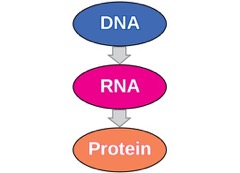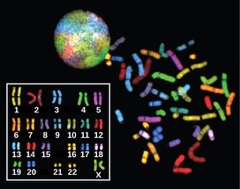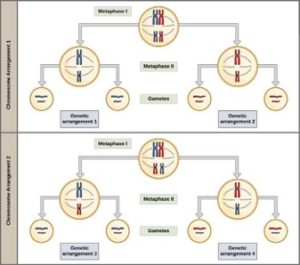48 Introduction to Genetics
“Genetics” is the study of how traits are inherited.A trait is defined as a variation in the physical appearance of a heritable characteristic. It seeks to understand how traits are passed from generation to generation. Before you start learning about the details of inheritance, let’s review some topics that are important in order to understand genetics.
Recall that genes are segments of DNA that are typically several hundred or thousand bases long. Each gene directs the production of a protein through the process of protein synthesis: DNA gets transcribed to produce an mRNA; mRNA provides to code for a ribosome to produce a chain of amino acids. Read this section of the book if you need to review this topic: How do genes direct the production of proteins?

Recall that eukaryotic genes are found on chromosomes and that each eukaryotic chromosome typically contains hundreds or thousands of genes. In most eukaryotes, including humans and other animals, each cell contains two copies of each chromosome. The reason we have two copies of each gene is that we inherit one from each parent.
In contrast to eukaryotes, prokaryotes have one circular chromosome. This means they have one copy of each gene.
Read this section of the book if you need to review this topic: How DNA is arranged in the cell

Chromosomes are inherited by the offspring from the parents via the egg or sperm. Inside one egg or one sperm is one copy of each chronometer (so 23 total in humans). When an egg is fertilized by a sperm, the resulting zygote (fertilized egg) will contain two copies of each chromosome, just like each of its parents.
Meiosis is the process that produces eggs and sperm. Eggs and sperm are also known as gametes. During meiosis, one copy of each paired chromosome is moved into the gamete. Cells with one copy of each chromosome are known as “haploid“. This separation, or segregation, of the homologous (paired) chromosomes means also that only one of the copies of the gene gets moved into a gamete.
The offspring are formed when that gamete unites with one from another parent and the two copies of each gene (and chromosome) are restored. Read this section of the book if you need more information on this topic: Overview of Meiosis

The offspring will receive two copies of each gene (one from each parent), but the copies are not necessarily identical. You already knew this – you don’t get identical information from your mother and your father because they have different DNA (which gives them different traits). The different versions of one specific gene are known as alleles. As you learn about genetics, you will learn about how the information from both alleles of a specific gene interact to give an individual their trait. The genetic information that an individual has is called their genotype. The genotype of an individual produces the individual’s phenotype, or physical traits.
References
Unless otherwise noted, images on this page are licensed under CC-BY 4.0 by OpenStax.
OpenStax, Concepts of Biology. OpenStax CNX. May 18, 2016 http://cnx.org/contents/s8Hh0oOc@9.10:8v2Xzdco@5/The-Structure-of-DNA


Feedback/Errata